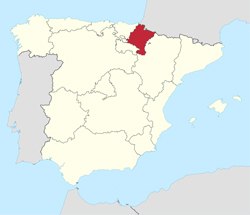Pamplona in Navarre

Navarre is a uniprovincial autonomous region in northern Spain. It borders on France to the northeast and, on the Spanish side, on the regions of the Basque Country, Aragón and La Rioja. There is also a small enclave, Petilla de Aragón, which is situated within the autonomous region of Aragón but which belongs to Navarre.
As a province, Navarre has a unique status within the Spanish system of autonomous regions that are made up of one or more provinces.
It is a chartered province; it was given this status in 1841 when it ceased being a kingdom and was ruled by a chartered provincial council under the Spanish crown. This means that the province is in charge of its own autonomous financing as opposed to almost all the other Spanish autonomous regions whose finances are regulated by the central government. The government of Navarre levy their own taxes and finance their own autonomous institutions and other outgoings.
 The highest point in Navarre is in the Pyrenees; it is called Mesa de los Tres Reyes and it reaches 2,438 metres into the sky. The capital of Navarre is Pamplona. The city of Pamplona is home to 201,653 of Navarre’s 647,554 inhabitants. Pamplona’s greatest claim to fame is, of course, the running of the bulls during its annual Fiesta de los Sanfermines. The fiesta was described by American novelist Ernest Hemmingway in his 1926 novel ‘The Sun Also Rises’, and soon it became a popular destination for Americans and Europeans who wanted to experience ‘the real Spain’.
The highest point in Navarre is in the Pyrenees; it is called Mesa de los Tres Reyes and it reaches 2,438 metres into the sky. The capital of Navarre is Pamplona. The city of Pamplona is home to 201,653 of Navarre’s 647,554 inhabitants. Pamplona’s greatest claim to fame is, of course, the running of the bulls during its annual Fiesta de los Sanfermines. The fiesta was described by American novelist Ernest Hemmingway in his 1926 novel ‘The Sun Also Rises’, and soon it became a popular destination for Americans and Europeans who wanted to experience ‘the real Spain’.
Today the fiesta is visited by a million people every year. It kicks off at midday on 6th July and the first running of the bulls is on 7th July, día de San Fermín. In 2020, however, the fiesta was cancelled, like so many other events, due to the corona virus.
The city of Pamplona is set in the centre of the ‘Pamplona Basin’, a large bowl shaped valley surrounded by high hills and opening out to the south into the Upper Ebro valley. The climate in Pamplona is pleasantly mild with plenty of rainfall. The average annual precipitation is about 800 mm. The summers are warm, usually with clear skies and mostly dry. The winters are cold with temperatures often dipping below zero; rain and snow abound.
Navarre has two universities. Universidad de Navarre which is a private, Catholic non-profit university. It is ranked as Spain’s best private university, and the 8th best overall; about 8,500 students enrolled in this fee-paying university for the 2019-2020 course. Universidad Pública de Navarre was founded in 1987 by the government of Navarre. It’s ranked as no. 12 on the list of Spanish universities and more than 10,000 students enrol yearly.
The natural conditions in the Pamplona Basin makes it ideal for human occupation and its earliest settlements date back to the first humans on the Iberian Peninsula, some 75,000 years.
A small town was later founded on the site by Roman legionaries under general Cneo Pompeyo Magno in 75 BC. They named it Pompaelo. From there the city grew over the centuries as the rule changed from Roman to Visigoth and from Muslim to Christian.
Like most other self respecting Spanish cities, Pamplona has its ramparts; these were constructed in the 16th century to surround the city and protect it from the French. The geographical situation of Pamplona was of high strategic importance and one of the only ways for conquerors from the north to access Spain. For this reason it has often been referred to as ‘The Key of Spain’ in historic documents. Construction of the present city wall was started in 1515; it was to replace the old medieval city wall, and it was five kilometres long. Today it is one of the best preserved and most interesting fortifications in Spain.
The number of inhabitants of Pamplona grew in the 18th century, but because of the city’s strategic importance construction and habitation outside the city walls were prohibited, so the city had to expand vertically. However, in the 19th century, living quarters became so cramped and conditions so unhealthy that the Pamplona city council repeatedly asked the central government for permission to expand the walls. This was turned down repeatedly until finally, on two occasions in 1915 and 1921 part of the walls was demolished.
During the first decade of the 21st century a great part of the fortifications was reconstructed and restored. Other outstanding monuments in Pamplona include the ‘Monumento al Encierre’, a monument to the running of the bulls. Whether or not you agree with this tradition, the monument in itself is worth visiting, a sculpture of running and fallen men closely followed by the enormous bulls; a moment of great movement and emotion frozen in time.
The Cathedral of Pamplona is situated on the edge of the Casco Viejo (the Old Quarter), in the same site that the old Roman city of Pompaelo was originally built. The cathedral is Gothic and it houses a large number of historic and artistic relics from the city’s past. Kings were crowned and parliaments convened in the cathedral and it was the seat of the royal court for three centuries. Apart from the charms and attractions of Pamplona city, Navarre is worth visiting for its many picturesque villages and towns, green valleys and stunning mountain landscapes.


